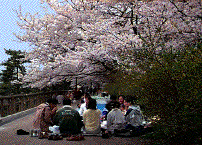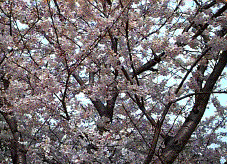
CHERRY-BLOSSOM VIEWING:
Flocking Under the Light-Pink Petals
to Celebrate Spring's Arrival
APRIL 23, 1996

The cherry blossom season has reached full swing in Japan, with groups of people converging on famous blossom-viewing sites to eat, drink, and make merry under trees resplendent with pink. An important event on the calendar since olden times, cherry-blossom viewing marks the advent of spring and is a time for rejoicing and reflection.
The Crowds at Ueno
The cherry-blossom front, representing flowering times on the four main islands of the Japanese archipelago, starts out in the southern plains of Kyushu at the end of March. From there it moves northeast at an average speed of 30 kilometers a day to reach Hokkaido at the beginning of May.
Graced by the branches of 2,200 cherry trees, Ueno Park is the place to go for blossom viewing in Tokyo. This year the blossoms came out at the end of March and reached full bloom the first weekend of April. The park is decorated with rows of lanterns and outdoor stalls selling a myriad of goodies, such as skewers of barbecued chicken and "oden," a dish of simmered vegetables and other ingredients. As night falls the lanterns cast a hazy light on the blossoms, creating an atmosphere of spring at its most alluring.
The number of visitors to Ueno Park surges at this time of year to more than 100,000 a day. Families, friends, co-workers, and other groups vie for a place under one of the trees for a party. As usual the flowers recede into the background as scenes of merrymaking unfold, with everybody feasting, pouring each other drinks, and taking turns at the microphone singing karaoke.

A National Pastime
Flower viewing has a long history. It got its start in the ninth century as a diversion for the nobility. In the middle of the eighteenth century, it grew in popularity among commoners. Cherry trees were transplanted around the country, and flower viewing evolved into a national pastime.
Cherry trees are not the only objects of flower viewing; plum trees draw crowds in early spring, azaleas and irises in early summer, and bush clovers in the fall. But more than any other flower, cherry blossoms occupy a special place in the hearts of the Japanese. Because they reach full splendor just when children start school, graduates start working, and transferred employees take up their new post, they serve as a reminder of new beginnings. At the same time their short-lived beauty, lasting just a week, symbolizes partings and the evanescence of life.